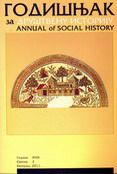Тумачење историје Византије у совјетском моделу уџбеника у Бугарској и Југославији 1945-1953
Interpretation of the Byzantine history in the translated Soviet textbooks in Bulgaria and Yugoslavia 1945-1953
Author(s): Olivera MarkovićSubject(s): History
Published by: Udruženje za društvenu istoriju
Keywords: history textbook; Bulgaria; Yugoslavia; USSR; Byzantium
Summary/Abstract: Political divisions in the USSR Communist Party during the 1930-ies, the end of World War II, beginning of the Cold War and break between Tito and Stalin were the events that influenced interpretation of Byzantine history in the Soviet textbook on general history of the Middle Ages. This textbook was used in Yugoslavia immediately after the war, while in Bulgaria it was put in use only as one of the consequences of the Cominform Resolution. In the older edition of this textbook, published in Moscow in 1943, which was used in Yugoslavia, preference was given to themes on Western Europe and feudalism. In the later edition, from 1947/8, which was used in Bulgaria, Byzantine history was understood as basis for explanation of the past of the Eastern bloc. Its use both in Bulgaria and Yugoslavia represented discontinuity in explanation of the importance of Byzantine history. Other textbooks on national histories respectively, explained Byzantine history in national discourses, and considered its role in the development of both states more important.
Journal: Godišnjak za društvenu istoriju
- Issue Year: 2011
- Issue No: 2
- Page Range: 51-66
- Page Count: 16
- Language: Serbian

